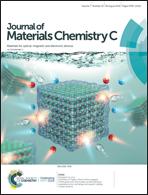In situ monitoring of plasmon-driven photocatalytic reactions at gas–liquid–solid three-phase interfaces by surface-enhanced Raman spectroscopy†
Abstract
Plasmon-driven photocatalytic reactions have been studied for years via both experimental and theoretical methods. In our study, plasmon-driven photocatalytic reactions were monitored at the gas–liquid–solid interface using superhydrophobic surface-enhanced Raman spectroscopy (SERS) substrates. Experiments were performed that compared substrates with different surface wettabilities by monitoring the conversion of p-aminothiophenol (PATP) and p-nitrothiophenol (PNTP) into p,p′-dimercaptoazobenzene (DMAB). A higher reaction degree was obtained on superhydrophobic substrates rather than hydrophilic substrates, verifying the dominant role of the oxidization process. Moreover, substrates with different morphologies were used and were also successfully employed for SERS monitoring. Thus, this study devised a new orientation at the gas–liquid–solid interface for further exploration of the plasmon-driven photocatalytic reaction in the future.



 Please wait while we load your content...
Please wait while we load your content...